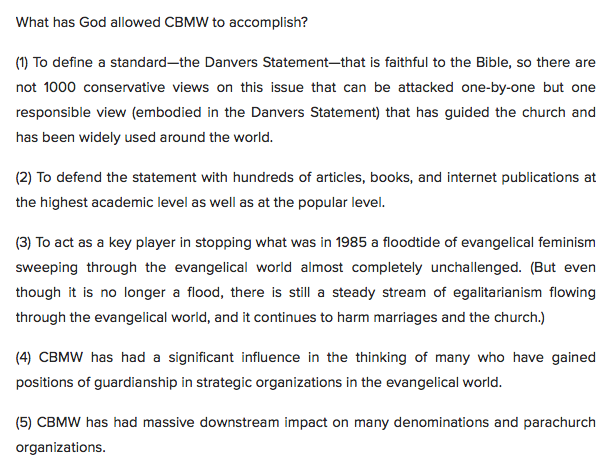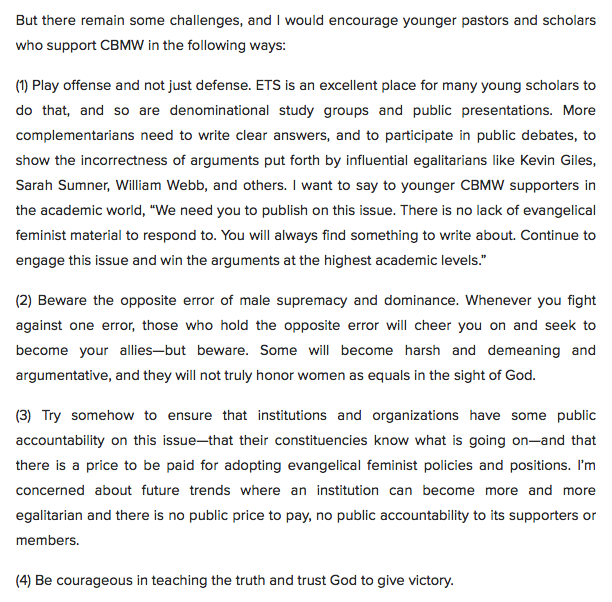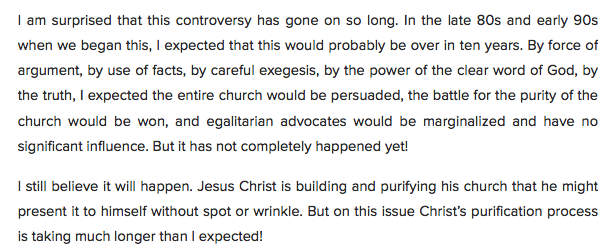"I am surprised that this controversy has gone on so long. In the late 80s and early 90s when we began this, I expected that this would probably be over in ten years."
 Silhouette Woman and Man Profile
Silhouette Woman and Man Profile
In Part 1 of the History of Complementarianism, we explained how a group of like-minded individuals drafted the Danvers Statement on Biblical Manhood and Womanhood under a cloak of secrecy. This statement, which was finalized in December 1987, serves as the foundational document for complementarianism (an invented term). It was during the secret meeting in Danvers, Massachusetts that the signatories voted to incorporate the Council on Biblical Manhood and Womanhood (CBMW). Thanks to Wayne Grudem's Personal Reflections, we have an accurate history of this movement.
NIV's Gender Neutral Bible
One of the early challenges CBMW faced was how to address the NIV's Gender Neutral Bible. At the November 1996 meeting of the Evangelical Theological Society, Wayne Grudem read a paper called “What’s Wrong With Gender Neutral Bible Translations?” In it he analyzed many verses in the New Revised Standard Version (NRSV) of the Bible but didn't discuss the NIV because there were no indications of a plan to change the gender language. In his personal reflections, Grudem revealed that he gave multiple copies of his paper to the Secretary of the NIV’s Committee on Bible Translation, who planned to share them with committee members.
A few months later the issue of gender-neutral Bible translation exploded. According to Wayne Grudem's Personal Reflections:
The March 1997 issue of World magazine had an NIV Bible on the cover that was morphing into a stealth bomber, and the magazine’s cover announced that the NIV was quietly going gender-neutral. The entire gender-neutral Bible controversy resulted, and the following issue of World had an article by me analyzing several verses where I thought the British Inclusive-Language NIV (NIVI) was distorting Scripture.
Eventually Dr. James Dobson called a meeting of twelve people at Focus on the Family in late May, 1997. It included representatives from CBMW, World magazine, the NIV’s Committee on Bible Translation, Zondervan (the distributor of the NIV), and the International Bible Society (the copyright holder for the NIV), and some others. But just before the meeting began, the IBS issued a statement saying they had “abandoned all plans” for changes in gender-related language in future editions of the NIV. So we thought the controversy was done and the NIV would remain faithful in its translation of gender-related language in the Bible.
Little did we know, however, that the Committee on Bible Translation for the NIV had not “abandoned all plans”! Far from it! Unknown to anyone outside their circles, for the next four years the Committee on Bible Translation, apparently with the quiet cooperation of people at Zondervan and the International Bible Society, continued working to produce a gender-neutral NIV. They had publicly “abandoned all plans,” but privately they were going full-steam ahead. Then suddenly in 2001, they announced unilaterally they were abandoning the agreement not to publish genderrelated changes in the NIV, and they published the TNIV New Testament in 2001 and the whole Bible in 2005.
Grudem explained that the TNIV was not very successful, which he saw as 'God's protection on the accuracy of his Word in English'. Had it not been for CBMW, there would not have been an organized way to oppose the TNIV, according to Grudem. He went on to state:
The long-term result of that controversy, which no one expected or foresaw at the time, was a new awareness of differences in Bible translation theory in the evangelical world. The dominance of dynamic equivalence theory has clearly been broken, and the trend now is decidedly toward essentially literal translation. CBMW played a large role in that, and I am thankful to the Lord that we were able to do that.
SBC's "Baptist Faith and Message" Addendum
The Council on Biblical Manhood and Womanhood had been in existence for just a decade when it began to make significant inroads into the largest Protestant denomination in the United States — the Southern Baptist Convention. When SBC messengers convened in 1998, they approved the addition of complementarian language to the denomination's doctrinal statement, called the "Baptist Faith and Message". The following language was added to the 1963 BF&M:
Wayne Grudem and his complementarian colleagues 'rejoiced' when this occurred. In his personal refiections, Grudem stated:
This is wonderfully helpful because it sets the denomination on the right course on this issue for a generation or more to come.
Two years later the Baptist Faith and Message 2000 (BFM2000) was adopted at the SBC annual meeting.
That same year (2000), CBMW co-sponsored a marriage and family conference in Dallas with Dennis Rainey's Family-Life. It would be interesting to know whether this conference was held prior to June 14, 2000 (when the BFM2000 was adopted) as well as who was in attendance. With regard to this event, Grudem stated:
That conference had a wonderful impact with ongoing influence in terms of books published and much networking and encouragement for others.
To this day, it's all about networking…
Grudem and Rainey went on to write a book entitled Pastoral Leadership for Manhood and Womanhood, which was published by Crossway Books in 2002. There are some familiar names in the Table of Contents.
In 2004 Grudem's 865-page book Evangelical Feminism and Biblical Truth was published by Multnomah Books. According to Grudem:
"It includes everything I’ve learned on biblical manhood and womanhood for the last twenty-five years."
Two years later Wayne Grudem's book Evangelical Feminism: A New Path to Liberalism was published. It was in this book that Grudem shared his conviction that…
Many evangelical feminists are not going to change their minds or be convinced because, it seems to me, they have repeatedly adopted principles or chosen exegetical decisions that undermine or deny the authority of Scripture. Once that abandoning of scriptural authority comes about, then a movement will not be persuaded by Scripture, and in that case, when the culture is going the other way, they will not ever be persuaded on this issue.
At the conclusion of this post, we are including a panel discussion held at one of the Together for the Gospel events entitled Complementarianism: Essential or Expendable? One of the panelists is Wayne Grudem's buddy John Piper, so you can imagine how the conversation goes…
In his Personal Reflections, Grudem summarizes all the accomplishments of the Council on Biblical Manhood and Womanhood. (see screen shot below)
Even though Wayne Grudem believes CBMW has made tremendous progress promoting biblical manhood and womanhood (aka complementarianism), he points out some challenges (see screen shot below):
So what would be the price to pay for going down the slippery slope toward egalitarianism?
What surprised me most in Wayne Grudem's Personal Reflections was the first paragraph of his conclusion (see below):
What I can't believe is that Grudem and gang expected everyone to bow down and worship their sacred gender roles without any questioning. Not only that, he infers that those who do not embrace 'blblical manhood and womanhood' as described in the Danvers Statement are impure.
The Council on Biblical Manhood and Womanhood (CBMW) website includes the following in their History:
CBMW has played a formative role in helping numerous denominations and organizations promote gospel-driven gender roles, including the Southern Baptist Convention and the Presbyterian Church of America. Under the leadership of leaders like Randy Stinson, Bruce Ware, and J. Ligon Duncan, CBMW increased its influence in the first decade of the 21st century, holding several major conferences on gender roles, launching CBMW.org, and publishing the Journal for Biblical Manhood & Womanhood. JBMWhas been published in journal form since 1994 and has fostered critical academic discussion of crucial exegetical, theological, and pastoral issues.
In 2015, many evangelical groups are convictionally complementarian. The contemporary surge of interest in the gospel and the greatness of God has coincided with widespread adoption of complementarianism, with many prominent churches, seminaries, authors, and para-church organizations joyfully celebrating God’s good design for manhood and womanhood, home and church.
CBMW is in its fourth decade of operation… God has used a once-fledgling outfit to lead many Christians and many churches to health, and we trust this work will only continue and grow by his grace.
Earlier this month it was announced that Owen Strachan, son-in-law of ESS proponent Bruce Ware (who is a close colleague of Wayne Grudem), has resigned as CBMW president. Denny Burk is the newly appointed CBMW president. Is the Council on Biblical Manhood and Womanhood really being blessed by God? We think not…





